Everyone’s favorite dessert flavor combination comes together in these easy no-bake chocolate peanut butter Easter egg candies! They’re like a homemade version of the popular Reese’s Peanut Butter Eggs, only a bit softer and sweeter, which makes the crisp, flaky sea salt on top a wonderful addition.
If you enjoy candy this time of year, these easy Buttercream Egg Candies are another egg-cellent choice. (Ha! Couldn’t resist.)
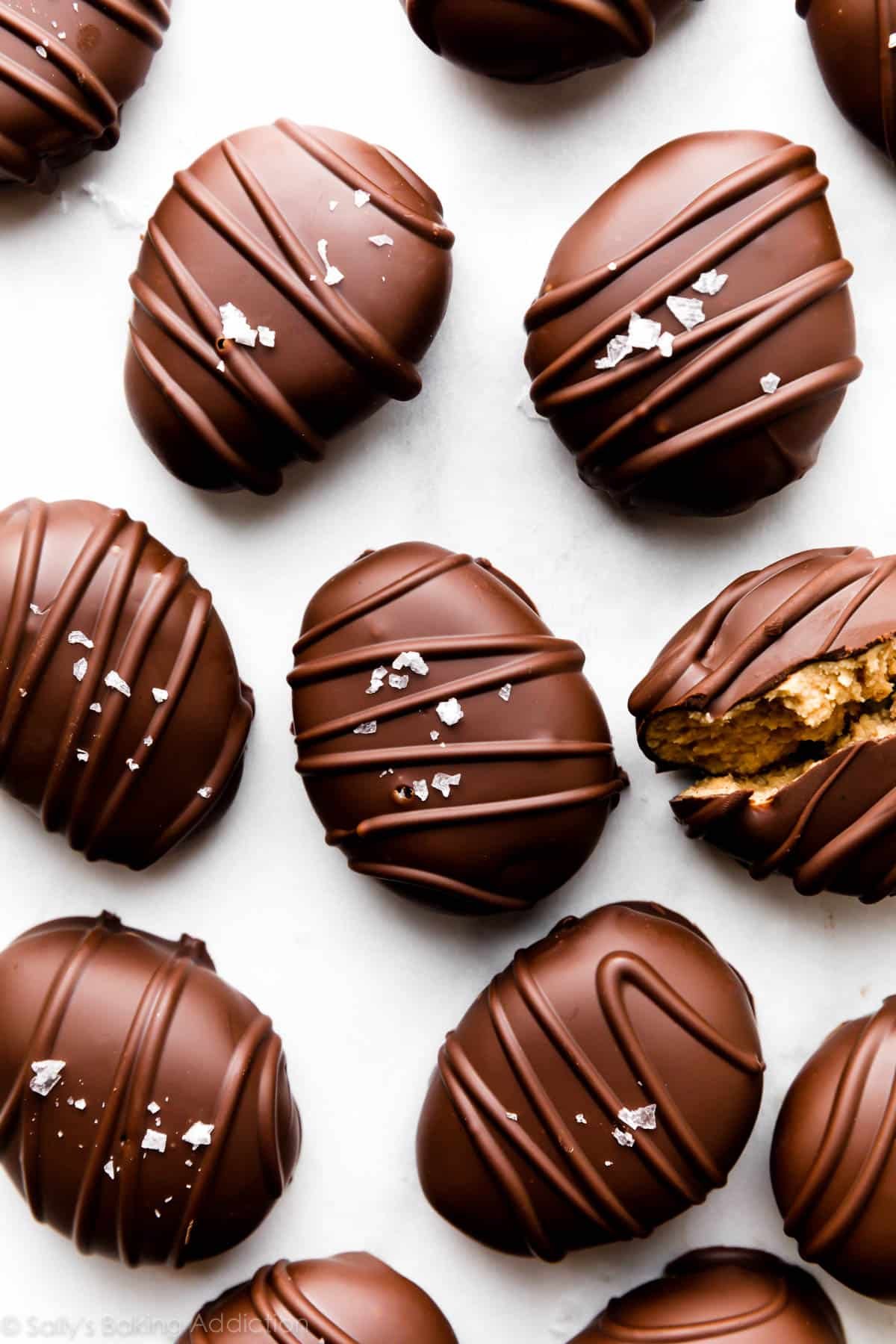
In 2015, I authored a cookbook all about making from-scratch candy and it includes some of my favorite recipes like classic chocolate fudge and caramel turtles. But the homemade peanut butter cups are certainly the crowd favorite, and I used a similar filling to create today’s peanut butter egg candies.
Tell Me About These Peanut Butter Eggs:
- Flavor: Indulge in peanut butter and chocolate bliss with every single bite of these egg-shaped candies. These homemade peanut butter eggs are certainly a special treat because they’re rich, sugary, and will satisfy your sweet cravings. You can coat the candies with dark, milk, or white chocolates. In today’s batch, I used a combination of dark and white chocolate to create a milk chocolate-like coating.
- Texture: The peanut butter filling is smooth, creamy, and thick. Dark bittersweet chocolate isn’t as soft as milk or white chocolates, so if you want a texture contrast to the creamy peanut butter filling, dark is the best candy coating choice.
- Ease: Homemade candy has the reputation of being finicky and complicated, but you don’t need a sugar PhD (LOL) or a fancy candy thermometer to make these. A beginner can easily master this recipe by following my detailed instructions below. These are EASY!
There are plenty of homemade peanut butter egg candy recipes online and I’m sure they are all wonderful! I really like this one because the filling is super creamy, but still holds its shape well.
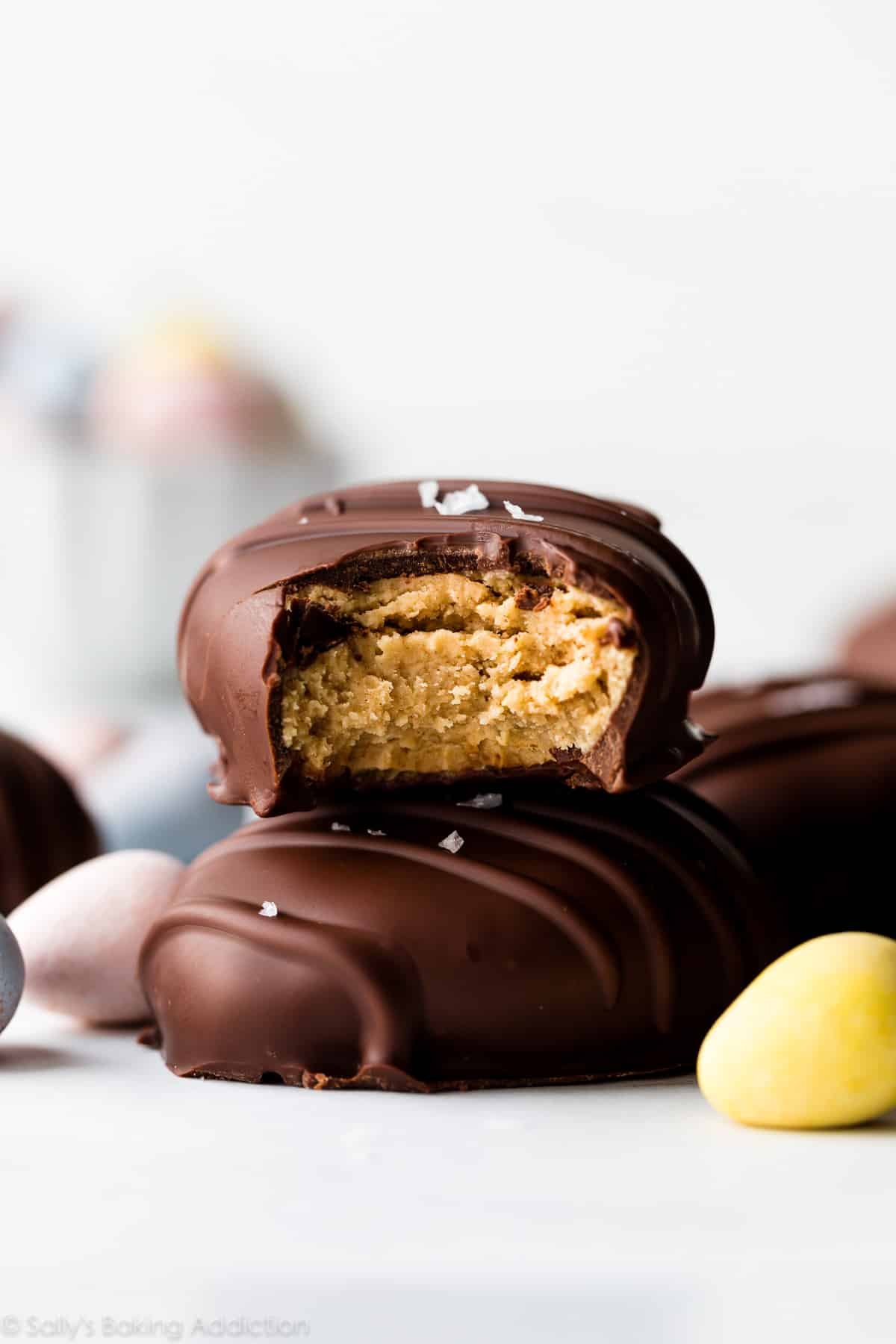
Have you ever made peanut butter balls before? This recipe is similar, only I reduced the butter and confectioners’ sugar so the peanut butter flavor comes through even more. The full printable recipe is below, but let’s walk through some particulars so you’re all set for sweet tooth success.
Just 7 Ingredients in These Easter Egg Candies

- Softened Butter: Like most baking recipes, start with room temperature butter. Overly soft or melted butter will sabotage your efforts from the start. Good rule of thumb: let the butter sit out on the counter for 1 hour before beginning the recipe. You can use salted or unsalted butter; if using salted, no need to adjust the added salt in the recipe—I promise these are plenty sweet either way.
- Creamy Peanut Butter: As you can guess, peanut butter is the main ingredient. For the best texture, use processed creamy peanut butter such as Jif or Skippy, the same kind I recommend for peanut butter blossoms, peanut butter frosting, and Reese’s peanut butter white chocolate bark. Natural-style peanut butter is wonderful for eating and cooking, but I do not recommend it for this recipe because the filling will be too dry and crumbly.
- Confectioners’ Sugar: Confectioners’ sugar binds everything together and adds sweetness. Without this powdery sugar, the peanut butter filling would be too liquid.
- Vanilla Extract: For a little extra flavor, use vanilla extract.
- Salt: Salt offsets the sweetness.
- Chocolate: Just as if you were making chocolate truffles, use pure baking chocolate. Do not use chocolate chips because they do not melt properly. I list all of my advice about the chocolate coating below.
- 1 Teaspoon Vegetable Oil: Melted chocolate can be a little too thick to smoothly coat the candies, so add a small splash of vegetable oil to help thin it out.
Optional: Sprinkle a little coarse sea salt or flaky sea salt on top of the chocolate before it sets. Or you can top the candies with festive sprinkles instead.
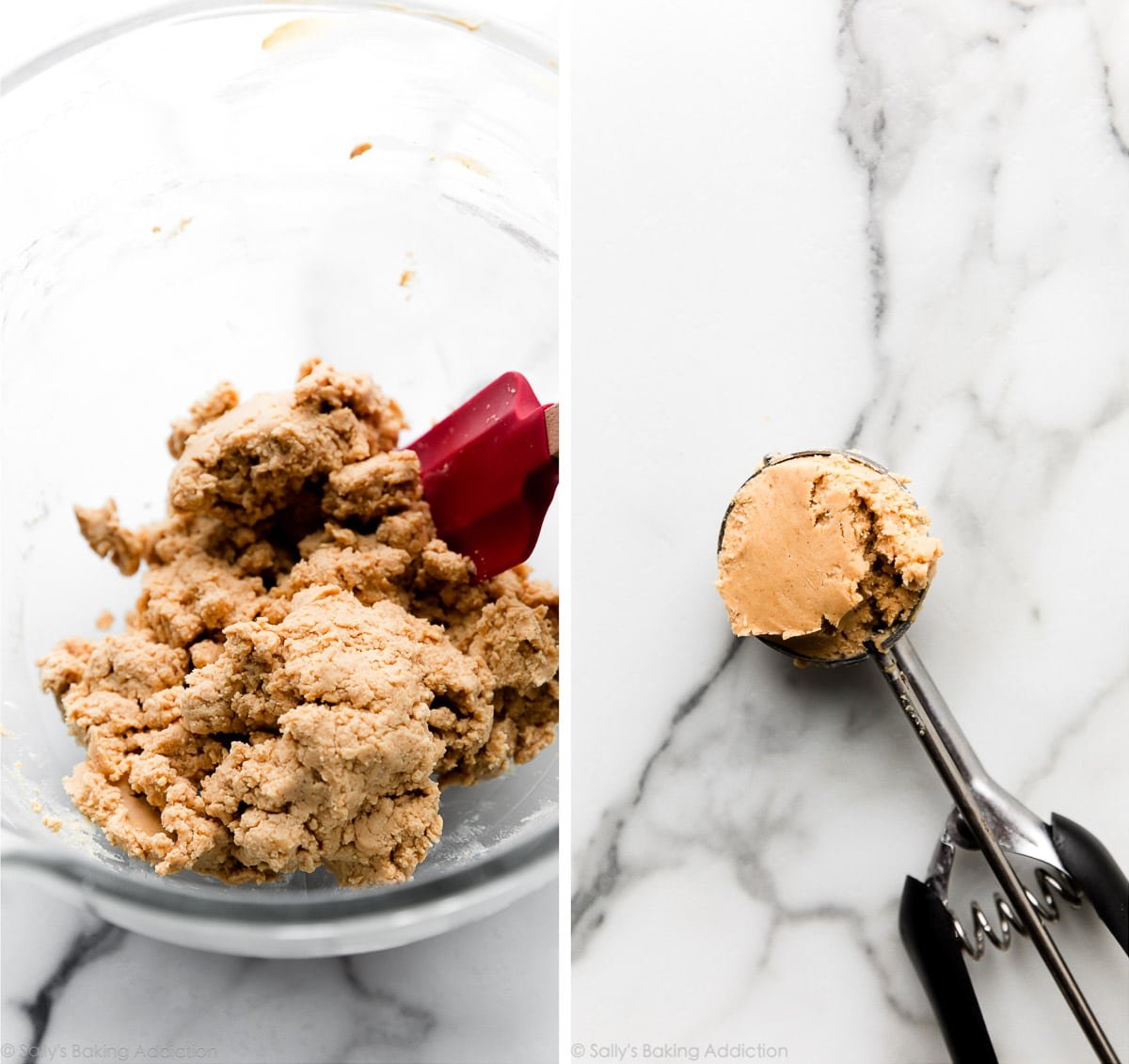
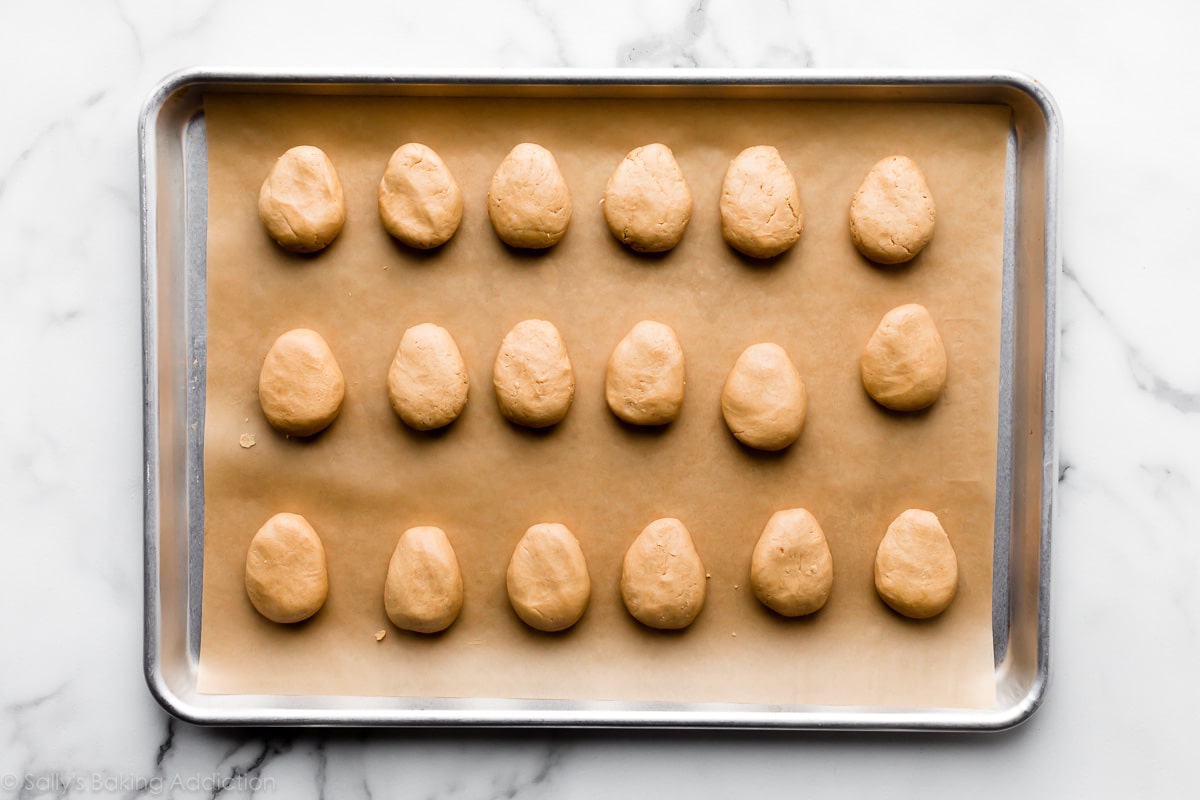
How to Shape Peanut Butter Egg Candies—It’s Easy!
You’re essentially making a very thick peanut butter filling and molding it into flat egg-like shapes. Each Easter egg candy is 1.5 Tablespoons (about 1 ounce, or 29 grams) of filling. For consistency and ease, I recommend using a medium cookie scoop or digital scale to measure the filling for each. First, roll the filling into a ball. Flatten it between your palms so it’s about 3/4 inch thick, and then use your fingers to narrow one end to make an egg shape. It’s easier than you think, and they certainly don’t need to be perfect!
If you’re having difficulty shaping the peanut butter eggs, here are some troubleshooting tips. If your filling is:
- Too Soft: If your butter was too soft or if the peanut butter you’re using is too thin, the filling can get a little soft and sticky. The refrigerator can fix that—stop what you’re doing and chill the bowl of filling for 15 minutes in the refrigerator before trying again.
- Too Crumbly: If the filling gets a little crumbly, keeping molding it and mashing it between your hands. The warmth of your hands can help bring it back together.
This Step Makes or Breaks Your Recipe—Literally
The most important part of this homemade Easter candy recipe is chilling the shaped eggs. When making buttercream egg candies, you must chill the buttercream mixture before shaping it because it’s too soft and unworkable. For these peanut butter eggs, however, you can shape the filling right after making it.
Chill the shaped peanut butter eggs in the refrigerator to set their shape. The colder the shaped eggs, the easier time you’ll have coating them.
If you skip chilling, the egg candies will completely fall apart when you try to coat them. Trust me, I’ve made these and plenty of other similar candies before, and you will absolutely lose your mind trying to coat them if they’re room temperature or warm.
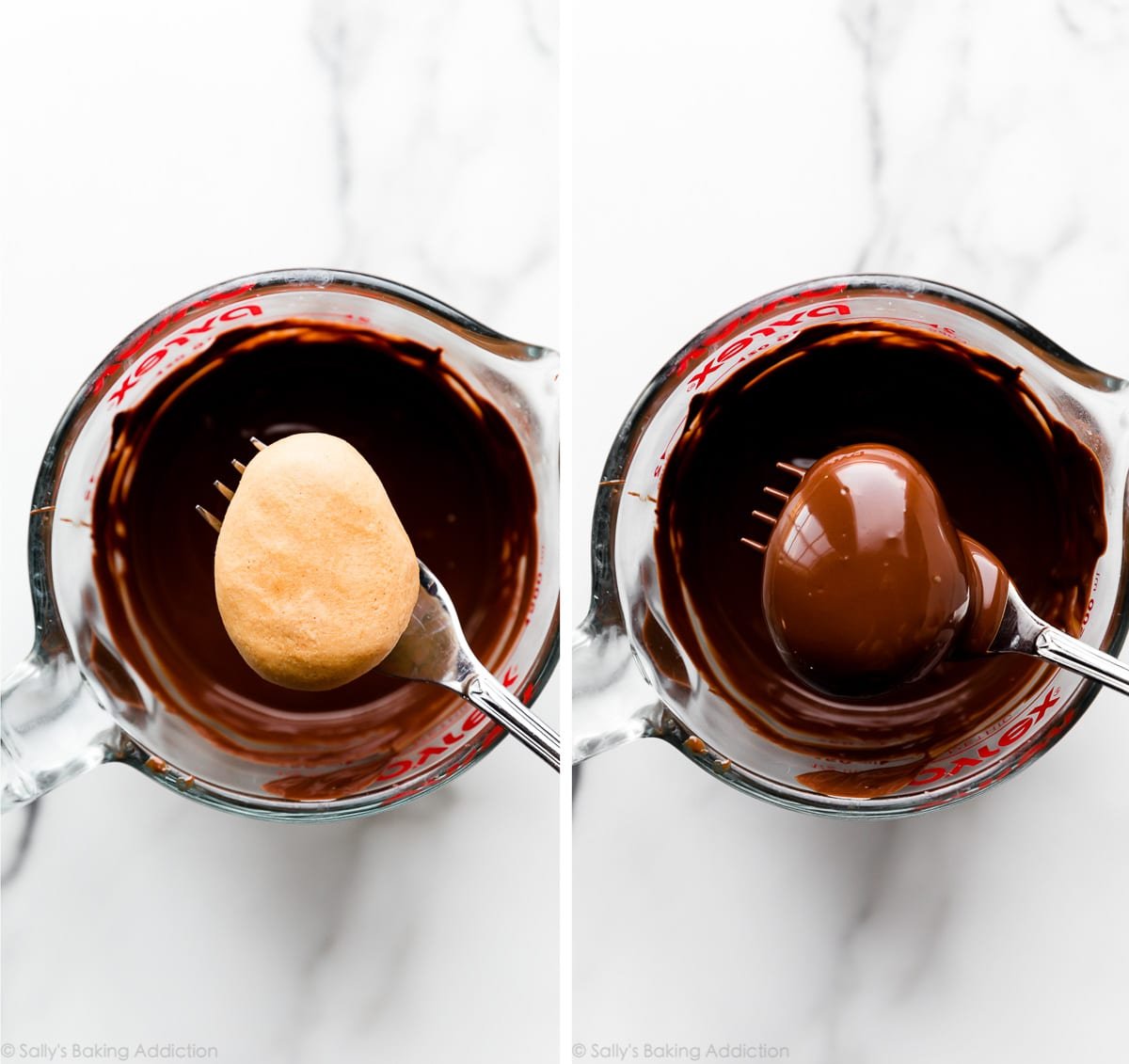
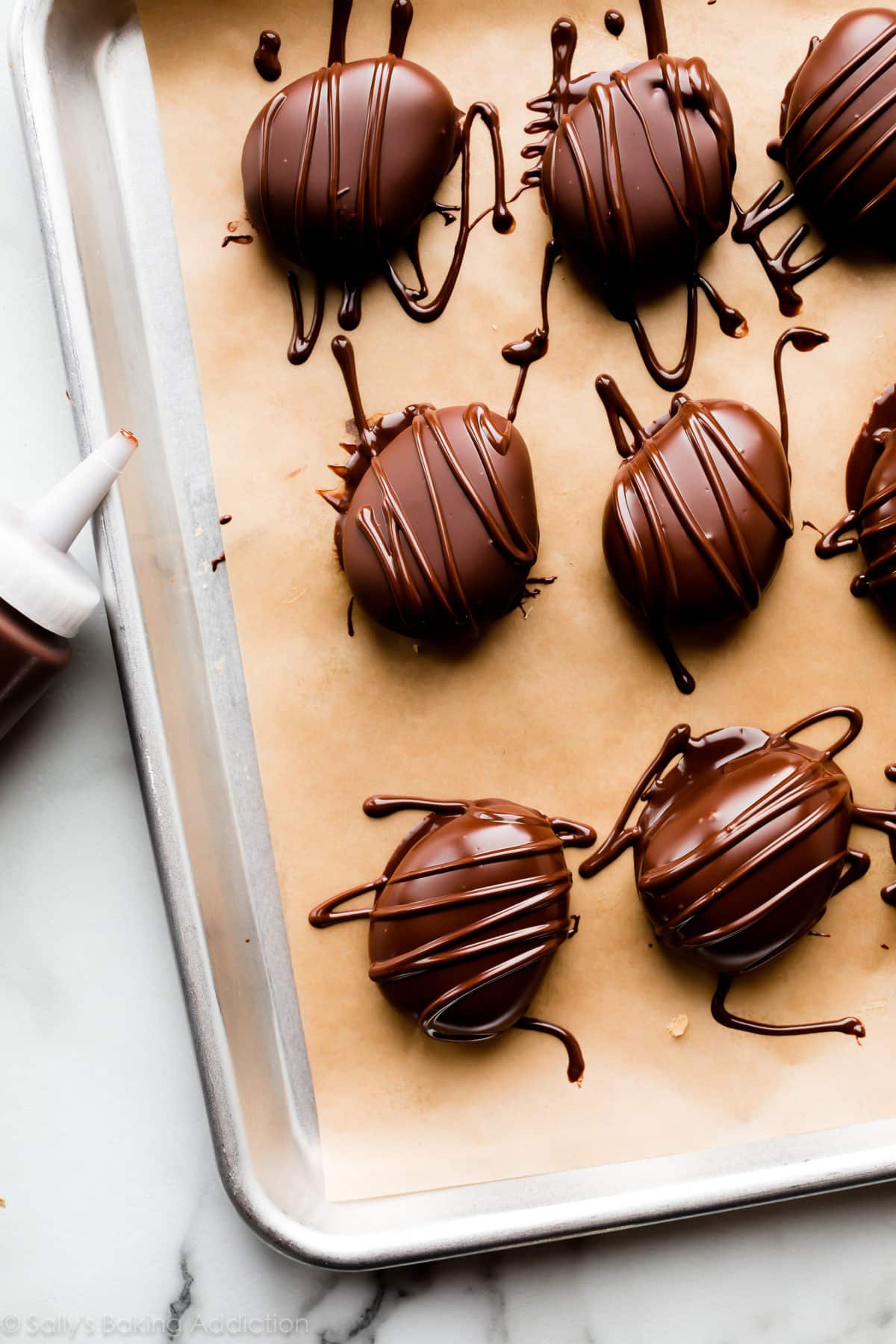
Success Tips for Coating the Peanut Butter Eggs
- Use real chocolate. For the BEST looking and tasting candies, start with real chocolate. Use the 4-ounce “baking chocolate” bars you can find in the baking aisle of the grocery store. I prefer Bakers or Ghirardelli brands. You need 3 4-ounce bars for this recipe, or 12 ounces total. Melting wafers also work, and for those, I recommend Ghirardelli. You can use milk, semi-sweet, dark, or even white chocolates. Be warned that using all white chocolate will produce a VERY sweet candy. Instead, I recommend dark or milk chocolates. I didn’t have any milk chocolate when I photographed these, so I mixed 8 ounces dark and 4 ounces white chocolate together. Candy melts would work, but they don’t taste like real chocolate, so I don’t recommend them. Do not use chocolate chips. Save them for your chocolate chip cookies or any of my other recipes using chocolate chips.
- Melt the chocolate. You can use a double boiler or the microwave. Microwave in 20-second increments, stirring after each. Chocolate is temperamental, so always melt with care. I do not recommend tempering the chocolate for this recipe. Tempered chocolate should not be refrigerated, and due to the fresh ingredients in the filling, these candies must be refrigerated.
- Let the chocolate cool down for a few minutes. Otherwise it will melt the cold filling.
- Dip the peanut butter eggs. While I prefer special dipping tools for round chocolate truffles, a fork and toothpick work perfectly for these flatter candies. Submerge the peanut butter eggs into the chocolate and then carefully lift out with a fork. Tap the fork on the edge of the bowl to drip off excess chocolate. Use a toothpick to help slide the candy off the fork.
- Allow the chocolate to set. Place the chocolate-covered eggs on a lined baking sheet. If you have leftover chocolate, drizzle it on top of the eggs—you can use a spoon or squeeze bottle for that. Place the baking sheet in the refrigerator to set the chocolate.
I repeat: Do not use chocolate chips. They’re great for chocolate chip cookies, but since they contain stabilizers, they do not melt into the correct coating consistency.
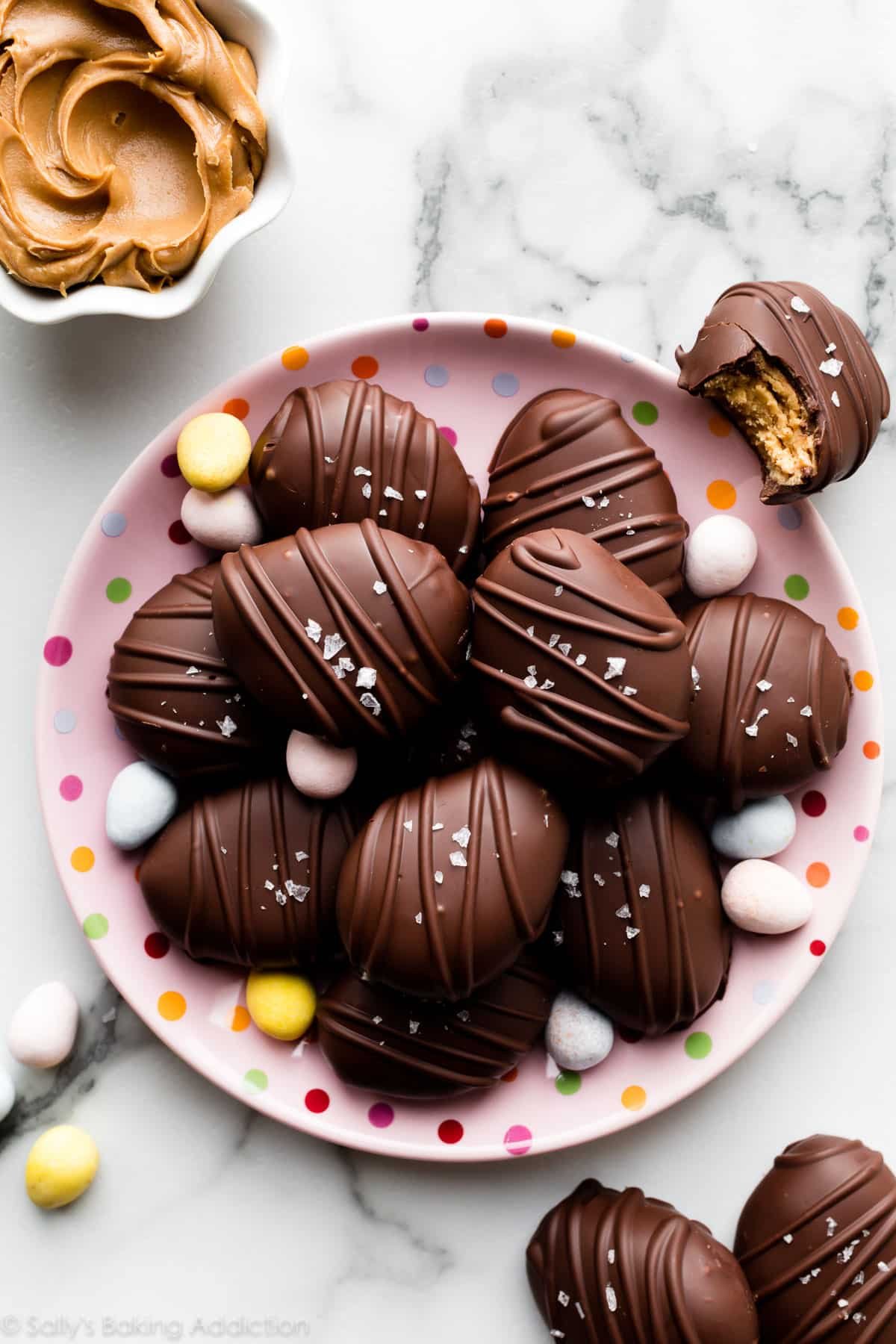
Troubleshoot: Coating in Chocolate
Your peanut butter Easter egg candy is perfectly shaped and cold, but dipping them into chocolate is giving you some problems. Let’s work through them together.
- Chocolate is hardening before I’m finished: This is an easy fix! First, make sure you are working quickly. Second, keep the chocolate fluid by reheating in the microwave for 10 seconds or use a double boiler. If you don’t have a double boiler, spoon the chocolate into a glass bowl set over a pot of simmering water. This keeps the chocolate slightly warm. Don’t let the water touch the bottom of the glass bowl.
- Chocolate is too thick: 1 teaspoon of vegetable oil thins out the chocolate so it’s the best consistency for dipping. If you find your chocolate is still too thick, add a little more vegetable oil. Coconut oil works too, but I prefer vegetable oil.
- Chocolate isn’t smooth on the candies: It was likely too thick. You want a very thin chocolate. See above.
- Filling is melting when dipping: The chocolate is too hot. Let it sit for a few minutes to slightly cool down and then try again.
- Uncoated candies are losing their shape: If the eggs are softening and losing their shape as you’re dipping them, put the baking sheet back in the fridge for 5–10 minutes and then try again.
More Easter Recipes
- Hummingbird Cake
- Coconut Easter Cake
- Carrot Cake Cupcakes
- Hot Cross Buns
- Lemon Meringue Pie
- Maple Pecan Sticky Buns
- Jelly Bean Sugar Cookies
- Sour Cream Crumb Cake
- Easter Cookies
- Coconut Chocolate Easter Cupcakes
Looking for more Easter inspiration? See all 18+ of our favorite Easter brunch recipes. And here are 18+ Easter dessert ideas.
Print
Easter Egg Peanut Butter Candies
- Prep Time: 1 hour, 30 minutes (includes chilling)
- Cook Time: 0 minutes
- Total Time: 2 hours (includes chocolate setting)
- Yield: 18 candies
- Category: Dessert
- Method: Dipping
- Cuisine: American
Description
These rich and sweet Easter egg peanut butter candies combine a creamy peanut butter filling with a delicious chocolate coating. See blog post for extra tips on coating the candies with chocolate.
Ingredients
- 6 Tablespoons (85g) unsalted butter, softened to room temperature
- 1 cup (250g) creamy peanut butter (not natural style)
- 2 and 1/2 cups (300g) confectioners’ sugar
- 1/2 teaspoon pure vanilla extract
- 1/8 teaspoon salt
- 12 ounces (3 4-ounce bars) semi-sweet chocolate bars (339g), coarsely chopped*
- 1 teaspoon vegetable oil
- optional: coarse sea salt or flaky sea salt, for topping
Instructions
- Line a large baking sheet with parchment paper or a silicone baking mat. Set aside.
- With a handheld or stand mixer fitted with a paddle attachment, beat the butter on medium-high speed until creamy and smooth, about 2 minutes. Add the peanut butter and beat until combined, about 1 minute. If you notice any small chunks of butter, don’t worry—the mixture will smooth out. Add the confectioners’ sugar, vanilla extract, and salt, and beat on low speed for 2 minutes until everything is combined. The mixture will be a little soft and crumbly.
- Measure 1.5 Tablespoons (about 1 ounce, or 29 grams) of peanut butter mixture. Roll into a ball. Flatten the ball between your palms and use your fingers to narrow one end into an egg shape. The egg should be roughly 3/4 inch thick. Place on the prepared baking sheet. Repeat with remaining peanut butter mixture. The mixture can be a little crumbly, but the warmth of your hands will bring it together. If you find the peanut butter mixture becoming too soft to handle, chill in the refrigerator for 15 minutes. Alternatively, you can powder your hands with confectioners’ sugar, which helps prevent the filling from sticking to your hands.
- Chill the shaped peanut butter eggs in the refrigerator for at least 1 hour and up to 1 day. During the last few minutes of the chilling time, begin melting the chocolate and oil together. You can melt it in a double boiler or the microwave. If using the microwave: place the chocolate and oil in a medium heat-proof bowl. I recommend using a liquid measuring cup because its depth makes dipping really easy. Melt in 20-second increments in the microwave, stirring after each increment, until completely melted and smooth. Let the warm chocolate sit for 6–8 minutes to cool slightly before dipping, otherwise it will melt the shaped peanut butter eggs.
- Remove peanut butter eggs from the refrigerator. Working with one at a time, submerge into the chocolate and then carefully lift out using a fork. Tap the fork gently on the side of the bowl/measuring cup to rid excess chocolate. Use a toothpick or a second fork to help slide the candy off of the fork and onto the baking sheet. If the eggs are softening and losing their shape as you’re dipping them, put the baking sheet back in the fridge for 5–10 minutes and then try again.
- If you have leftover chocolate, drizzle it over the candies. I reheat leftover chocolate and use a spoon or squeeze bottle to drizzle. If desired, lightly sprinkle each with coarse or flaky sea salt or festive sprinkles while chocolate is still wet.
- Refrigerate coated candies for 30 minutes or until chocolate has completely set before serving.
- Layer peanut butter eggs between sheets of parchment or wax paper and store in an airtight container in the refrigerator for up to 2 weeks. The filling can get a little soft, so they taste best right out of the refrigerator. We love them right out of the freezer, too!
Notes
- Make Ahead & Freezing Instructions: You can start this recipe 1 day ahead of time. The shaped filling can be chilled in the refrigerator for up to 1 day prior to coating. The coated peanut butter candies can be frozen. Freeze the coated candies for up to 3 months. Thaw overnight in the refrigerator.
- Special Tools (affiliate links): Electric Mixer (Handheld or Stand) | Baking Sheet | Silicone Baking Mat or Parchment Paper | Medium Cookie Scoop or Digital Scale | Double Boiler or Liquid Measuring Cup | Squeeze Bottle | Coarse Sea Salt or Flaky Sea Salt
- Butter: I use unsalted butter in this recipe, though I’ve made them plenty of times before with salted butter. No need to adjust the salt in the filling, though feel free to taste the filling before adding the salt and only add a pinch if desired. Because the filling and coating are so sweet, I never adjust the salt if using salted butter.
- Can I Use Crunchy Peanut Butter? Creamy/smooth is best because crunchy yields a very crumbly filling that’s difficult to mold. If crunchy is all you have, you can make it work in a pinch—just be warned the filling mixture will be super crumbly and you’ll really have to work it with your hands to mold into shapes.
- Chocolate: For the best looking and tasting candies, use 4-ounce “baking chocolate” bars found in the baking aisle. I prefer Bakers or Ghirardelli brands. You need 3 4-ounce bars for this recipe, 12 ounces total. You can use milk, semi-sweet, or bittersweet chocolates. (I combined 8 ounces dark and 4 ounces white chocolate to yield a lighter, milk chocolate-like coating.) You could also use chocolate melting wafers, such as Ghirardelli brand. Candy melts or almond bark work too, but they don’t taste like real chocolate. Do not use chocolate chips because they contain stabilizers preventing them from melting into the correct consistency for coating.
- Coating/Melting Chocolate: See all my troubleshooting tips above in the post.
- Do Not Temper: I do not recommend tempering the chocolate for this recipe. Tempered chocolate should not be refrigerated and due to the fresh ingredients in the filling, these candies must be refrigerated.






















Why isn’t Sally’s Candy Addiction available new?
Hi Lyn, unfortunately, Sally’s Candy Addiction is no longer being published, but it is available as an e-book (if that is an option for you). Many local libraries carry it, too. So sorry!
I’m not sure why it says the yield is only 18, I got 28 and some of mine were definitely over 30g per peanut butter ball. I weighed the first few to get a sense of the size.
I didn’t have any issue with the peanut filling being crumbly, it was very sticky probably because it was a hot summer day. I just made discs, it was my first time making chocolate candies…they don’t look anything like Sally’s lol…just big lumpy discs from me trying to drizzle chocolate.
I used 8 oz baker’s semi sweet chocolate and 4 oz semi sweet chips when I ran out. The baker’s chocolate is definitely better, it is more “crisp”. The chips remained quite soft, more like fudge.
Baker’s chocolate is just so expensive, more than twice the cost of chips, even the better brands of chocolate chips.
I tried this recipe for a fellowship and they were a HUGE hit. They were gone before I even got into the line!
Love these but mine tasted too much like Buckeyes and not Reese’s…. any suggestions? Smaller pb center and more chocolate?
Hi Lauren, yes you could try making them thinner so there’s less peanut butter filling.
This is a great basic PB egg recipe. They are very sweet and rich, but not quite as much as other recipes I’ve tried before. They were pretty soft even in just the fridge, so I stored them in the freezer and found them to be much better that way.
I have just made these and they are easy to make and delicious!
Thank you Sally!!
What a fun and delicious project!
If we don’t temper the chocolate will stay soft? Not have a snap to it?
Hi Jean, we do not recommend tempering the chocolate for this recipe. Tempered chocolate should not be refrigerated, and due to the fresh ingredients in the filling, these candies must be refrigerated. The chocolate will still harden nicely once set.